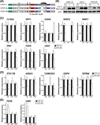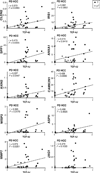Upregulation of T-cell factor-4 isoform-responsive target genes in hepatocellular carcinoma
- PMID: 23651211
- PMCID: PMC3706555
- DOI: 10.1111/liv.12188
Upregulation of T-cell factor-4 isoform-responsive target genes in hepatocellular carcinoma
Abstract
Background: The Wnt/β-catenin signalling pathway regulates genes involved in cell proliferation, survival, migration and invasion through regulation by T-cell factor (TCF)-4 transcription factor proteins. However, the role of TCF-4 isoforms generated by alternative splicing events in hepatocellular carcinoma (HCC) is unknown.
Aim: Here, we investigated TCF-4 isoforms (TCF-4J and K)-responsive target genes that are important in hepatic oncogenesis and tumour development.
Methods: Gene expression microarray was performed on HCC cells overexpressing TCF-4J and K isoforms. Expression level of selected target genes was evaluated and correlations were made between their expression level and that of TCF-4 isoform in 47 pairs of human HCC tumours.
Results: Comparison by gene expression microarray revealed that 447 genes were upregulated and 343 downregulated more than 2.0-fold in TCF-4J compared with TCF-4K expressing cells. We validated expression of 18 selected target genes involved in Wnt/β-catenin, insulin/IGF-1/IRS1 and Notch signalling pathways in 47 pairs of human HCCs and adjacent uninvolved liver tissues. It was observed that 13 genes (CLDN2, STK17B, SPP1, AXIN2, WISP2, MMP7, IRS1, ANXA1, CAMK2N1, ASPH, GPR56, CD24 and JAG1) activated by TCF-4J isoform in HCC cells, were also upregulated in HCC tumours compared with adjacent peritumour tissue; more importantly, 10 genes exhibited a significant correlation with the TCF-4J expression level in tumour.
Conclusion: TCF-4 isoforms (TCF-4J and K) activated different downstream target genes in HCC. The biological consequence of TCF-4J isoform expression was upregulation of genes associated with tripartite Wnt/β-catenin, insulin/IGF-1/IRS1 and Notch signal transduction pathway activation, which contribute to the pathogenesis of HCC.
Keywords: HCC; TCF-4; Wnt; target genes.
© 2013 John Wiley & Sons A/S. Published by John Wiley & Sons Ltd.
Conflict of interest statement
None
Figures





Similar articles
-
Loss of the SxxSS motif in a human T-cell factor-4 isoform confers hypoxia resistance to liver cancer: an oncogenic switch in Wnt signaling.PLoS One. 2012;7(6):e39981. doi: 10.1371/journal.pone.0039981. Epub 2012 Jun 29. PLoS One. 2012. PMID: 22768190 Free PMC article.
-
Loss of exon 4 in a human T-cell factor-4 isoform promotes hepatic tumourigenicity.Liver Int. 2013 Nov;33(10):1536-48. doi: 10.1111/liv.12189. Epub 2013 May 6. Liver Int. 2013. PMID: 23648141 Free PMC article.
-
Identification of T-cell factor-4 isoforms that contribute to the malignant phenotype of hepatocellular carcinoma cells.Exp Cell Res. 2011 Apr 15;317(7):920-31. doi: 10.1016/j.yexcr.2011.01.015. Epub 2011 Jan 20. Exp Cell Res. 2011. PMID: 21256126 Free PMC article.
-
Wnt signaling in hepatocellular carcinoma: analysis of mutation and expression of beta-catenin, T-cell factor-4 and glycogen synthase kinase 3-beta genes.J Gastroenterol Hepatol. 2003 Mar;18(3):280-7. doi: 10.1046/j.1440-1746.2003.02973.x. J Gastroenterol Hepatol. 2003. PMID: 12603528
-
Alterations of beta-catenin and Tcf-4 instead of GSK-3beta contribute to activation of Wnt pathway in hepatocellular carcinoma.Chin Med J (Engl). 2003 Dec;116(12):1885-92. Chin Med J (Engl). 2003. PMID: 14687479
Cited by
-
Evaluation of STK17B as a cancer immunotherapy target utilizing highly potent and selective small molecule inhibitors.Front Immunol. 2024 Oct 21;15:1411395. doi: 10.3389/fimmu.2024.1411395. eCollection 2024. Front Immunol. 2024. PMID: 39502695 Free PMC article.
-
Integrated gene-metabolite association network analysis reveals key metabolic pathways in gastric adenocarcinoma.Heliyon. 2024 Aug 30;10(17):e37156. doi: 10.1016/j.heliyon.2024.e37156. eCollection 2024 Sep 15. Heliyon. 2024. PMID: 39319160 Free PMC article.
-
The emerging role of WISP proteins in tumorigenesis and cancer therapy.J Transl Med. 2019 Jan 16;17(1):28. doi: 10.1186/s12967-019-1769-7. J Transl Med. 2019. PMID: 30651114 Free PMC article. Review.
-
STK17B promotes the progression of ovarian cancer.Ann Transl Med. 2021 Mar;9(6):475. doi: 10.21037/atm-21-601. Ann Transl Med. 2021. PMID: 33850872 Free PMC article.
-
Chronic Ethanol-Induced Impairment of Wnt/β-Catenin Signaling is Attenuated by PPAR-δ Agonist.Alcohol Clin Exp Res. 2015 Jun;39(6):969-79. doi: 10.1111/acer.12727. Epub 2015 Apr 23. Alcohol Clin Exp Res. 2015. PMID: 25903395 Free PMC article.
References
-
- Clevers H. Wnt/beta-catenin signaling in development and disease. Cell. 2006;127:469–480. - PubMed
-
- Ying Y, Tao Q. Epigenetic disruption of the WNT/beta-catenin signaling pathway in human cancers. Epigenetics. 2009;4:307–312. - PubMed
-
- El-Serag HB, Rudolph KL. Hepatocellular carcinoma: epidemiology and molecular carcinogenesis. Gastroenterology. 2007;132:2557–2576. - PubMed
Publication types
MeSH terms
Substances
Grants and funding
LinkOut - more resources
Full Text Sources
Other Literature Sources
Medical
Molecular Biology Databases
Research Materials
Miscellaneous

